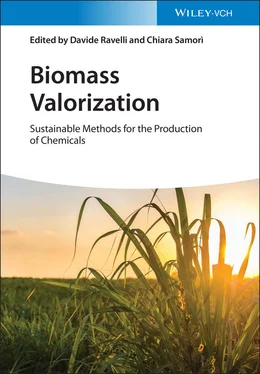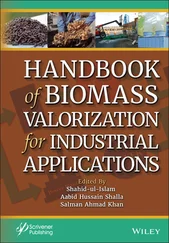Biomass Valorization
Здесь есть возможность читать онлайн «Biomass Valorization» — ознакомительный отрывок электронной книги совершенно бесплатно, а после прочтения отрывка купить полную версию. В некоторых случаях можно слушать аудио, скачать через торрент в формате fb2 и присутствует краткое содержание. Жанр: unrecognised, на английском языке. Описание произведения, (предисловие) а так же отзывы посетителей доступны на портале библиотеки ЛибКат.
- Название:Biomass Valorization
- Автор:
- Жанр:
- Год:неизвестен
- ISBN:нет данных
- Рейтинг книги:3 / 5. Голосов: 1
-
Избранное:Добавить в избранное
- Отзывы:
-
Ваша оценка:
- 60
- 1
- 2
- 3
- 4
- 5
Biomass Valorization: краткое содержание, описание и аннотация
Предлагаем к чтению аннотацию, описание, краткое содержание или предисловие (зависит от того, что написал сам автор книги «Biomass Valorization»). Если вы не нашли необходимую информацию о книге — напишите в комментариях, мы постараемся отыскать её.
Explore the potential of biomass-based chemicals with this comprehensive new reference from leading voices in the field Biomass Valorization: Sustainable Methods for the Production of Chemicals
Biomass Valorization: Sustainable Methods for the Production of Chemicals
Biomass Valorization — читать онлайн ознакомительный отрывок
Ниже представлен текст книги, разбитый по страницам. Система сохранения места последней прочитанной страницы, позволяет с удобством читать онлайн бесплатно книгу «Biomass Valorization», без необходимости каждый раз заново искать на чём Вы остановились. Поставьте закладку, и сможете в любой момент перейти на страницу, на которой закончили чтение.
Интервал:
Закладка:
Table of Contents
1 Cover
2 Title Page Biomass Valorization Sustainable Methods for the Production of Chemicals Editors Prof. Davide Ravelli Chiara Samorì
3 Copyright Editors Prof. Davide Ravelli University of Pavia Department of Chemistry viale Taramelli 12 27100 Pavia Italy Prof. Chiara Samorì University of Bologna Department of Chemistry “Giacomo Ciamician” via S. Alberto 163 48123 Ravenna Italy Cover © TB studio/Shutterstock All books published by WILEY‐VCH are carefully produced. Nevertheless, authors, editors, and publisher do not warrant the information contained in these books, including this book, to be free of errors. Readers are advised to keep in mind that statements, data, illustrations, procedural details or other items may inadvertently be inaccurate. Library of Congress Card No.: applied for British Library Cataloguing‐in‐Publication Data A catalogue record for this book is available from the British Library. Bibliographic information published by the Deutsche Nationalbibliothek The Deutsche Nationalbibliothek lists this publication in the Deutsche Nationalbibliografie; detailed bibliographic data are available on the Internet at < http://dnb.d-nb.de >. © 2021 WILEY‐VCH GmbH, Boschstr. 12, 69469 Weinheim, Germany All rights reserved (including those of translation into other languages). No part of this book may be reproduced in any form – by photoprinting, microfilm, or any other means – nor transmitted or translated into a machine language without written permission from the publishers. Registered names, trademarks, etc. used in this book, even when not specifically marked as such, are not to be considered unprotected by law. Print ISBN: 978‐3‐527‐34717‐9 ePDF ISBN: 978‐3‐527‐82501‐1 ePub ISBN: 978‐3‐527‐82503‐5 oBook ISBN: 978‐3‐527‐82502‐8
4 Foreword
5 Preface
6 1 Role of Biomass in the Production of Chemicals 1.1 Introduction 1.2 Biomass Valorization 1.3 Lignocellulosic Biomass 1.4 Key Biomolecules 1.5 Solvents 1.6 Pretreatment of Lignocelluloses 1.7 Conclusions and Perspectives References
7 Section I: Catalytic Strategies 2 Biomass Processing via Acid Catalysis 2.1 Introduction 2.2 Acid‐Catalyzed Processing of Cellulosic Polysaccharides 2.3 Acid‐Catalyzed Processing of Lignin 2.4 Conclusions and Perspectives References 3 Biomass Processing via Base Catalysis 3.1 Introduction 3.2 Aldol Condensation 3.3 Ketonization Reaction of Carboxylic Acids 3.4 Transesterification Reaction 3.5 Conclusions and Perspectives References 4 Biomass Processing via Metal Catalysis 4.1 Introduction 4.2 Synthetic Strategies for Supported Metal Nanoparticles 4.3 Furfural 4.4 5‐Hydroxymethylfurfural (HMF) 4.5 Conclusions and Perspectives References 5 Biomass Processing with Biocatalysis 5.1 Introduction 5.2 Generations of Renewable Biomass: Advantages and Limitations 5.3 Advantages and Limitations of Biocatalysis 5.4 Enzyme Discovery and Optimization of Enzyme Performance 5.5 Enzyme Immobilization 5.6 Enzymatic Hydrolysis of Starch to Glucose 5.7 Enzymatic Depolymerization of Lignocellulose 5.8 Enzymatic Hydrolysis of Cellulose and Hemicellulose 5.9 Enzymatic Hydrolysis of 3rd Generation (3G) Polysaccharides 5.10 Commodity Chemicals from Carbohydrates (Monosaccharides) 5.11 Enzymatic Conversions of Triglycerides: Production of Biodiesel and Bulk Chemicals 5.12 Conclusions and Perspectives References
8 Section II: Thermal Strategies 6 Biomass Processing via Pyrolysis 6.1 Brief Introduction 6.2 Chemicals from Cellulose Pyrolysis 6.3 Chemicals from Lignin Pyrolysis 6.4 Pyrolysis of Biomass 6.5 Conclusions and Perspectives References 7 Biomass Processing via Thermochemical–Biological Hybrid Processes 7.1 Introduction 7.2 Pyrolysis Products (PyP) from the Microorganism's Standpoint 7.3 Conversion of PyP with MMC: Survey of Experimental Evidence 7.4 Feasible Pathways for Producing Chemicals from PyP with MMC 7.5 Conclusions and Perspectives References
9 Section III: Advanced/Unconventional Strategies 8 Biomass Processing via Electrochemical Means 8.1 Introduction 8.2 Electrochemical Conversion of Bio‐Based Molecules 8.3 Conversion of Sugars 8.4 Conversion of Furanics 8.5 Conversion of Levulinic Acid 8.6 Conversion of Glycerol 8.7 Lignin Depolymerization 8.8 Scale‐up of Electrosynthesis of Biomass‐Derived Chemicals 8.9 Conclusions and Perspectives References 9 Biomass Processing via Photochemical Means 9.1 Introduction 9.2 Fundamental Aspects of Photoredox Catalysis 9.3 Photochemical Valorization of Lignin 9.4 Conclusions and Perspectives References Note 10 Biomass Processing via Microwave Treatment 10.1 Introduction 10.2 Microwave–Matter Interaction: Advantages and Limitations in the Processing of Biomass 10.3 Microwave Pyrolysis 10.4 Microwave‐assisted Hydrolysis 10.5 Microwave‐assisted Extraction of Phytochemical Compounds 10.6 Conclusions and Perspectives References 11 Biomass Processing Assisted by Ultrasound 11.1 Introduction 11.2 Ultrasound Background 11.3 Ultrasound‐Assisted Biomass Pretreatments 11.4 Ultrasound‐Assisted Biomass Conversion 11.5 Ultrasound‐Assisted Extraction of Value‐Added Compounds 11.6 Alternative Solvents 11.7 Conclusions and Perspectives References 12 Biomass Processing via Mechanochemical Means 12.1 Overview and Introduction 12.2 Crystallinity Reduction in Biopolymers via Mechanochemistry 12.3 Mechanochemical Transformations of Polysaccharides 12.4 Mechanochemical Transformations of Amino Acids, Nucleotides, and Related Materials 12.5 Mechanochemical Treatment of Lignin 12.6 Biominerals from Mechanochemical Processing of Biomass 12.7 Conclusions and Perspectives References
10 Section IV: Closing Remarks 13 Industrial Perspectives of Biomass Processing 13.1 Replacing Existing Petrochemicals with Alternatives from Biomass: An Introduction 13.2 Oleochemical Biorefinery: A Consolidated and Multifaceted Example of Biomass Processing 13.3 From Sugar to Bio‐monomers: The Case of 2,5‐Furandicarboxylic Acid (FDCA) 13.4 From Bioethanol to Rubber: The Synthesis of Bio‐butadiene 13.5 Conclusions and Perspectives References
11 Index
12 End User License Agreement
List of Tables
1 Chapter 1Table 1.1 Key examples of the possible bio‐based products, state‐of‐the‐art p... Table 1.2 Advantages and disadvantages of pretreatment methods for lignocellu...
2 Chapter 2 Table 2.1 Conditions and results of the acid‐catalyzed processing of cellulos... Table 2.2 Conditions and results of the acid‐catalyzed processing of cellulos...
3 Chapter 3Table 3.1 Summary of catalytic reaction performance of glycerol carbonylation...
4 Chapter 4Table 4.1 Catalysts for the hydrogenation of furfural to furfuryl alcohol.Table 4.2 Catalysts for the hydrogenation of furfural or furfuryl alcohol to ...Table 4.3 Catalysts for the hydrogenation of furfural to pentanediols.Table 4.4 Catalysts for the hydrogenation of furfural to 2‐methylfuran.Table 4.5 Catalysts for the oxidative esterification of furfural.Table 4.6 Catalytic hydrogenation and hydrogenolysis of HMF over (bi)metallic...Table 4.7 Catalysts for the oxidation of HMF to FDCA.
5 Chapter 6Table 6.1 Typical pyrolysis of lignocellulosic biomass for chemicals.
6 Chapter 7Table 7.1 Comparison of growth rate of different MMC consortia and related vo...Table 7.2 50% Inhibition concentrations (IC 50) expressed in mg/l of 27 pyroly...Table 7.3 Survey of literature about biological conversion of PyP.
7 Chapter 8Table 8.1 Main factors influencing the selectivity of an electrochemical reac...Table 8.2 List of commercial and pilot processes for conversion of bio‐based ...
8 Chapter 10Table 10.1 Microwave ISM (i.e. available for industrial, scientific and medic...Table 10.2 Room temperature dielectric properties (expressed as tan δ ) a...Table 10.3 Comparison between the decomposition temperatures for several biom...Table 10.4 Existing markets for the fermentation products resulting from acid...
Читать дальшеИнтервал:
Закладка:
Похожие книги на «Biomass Valorization»
Представляем Вашему вниманию похожие книги на «Biomass Valorization» списком для выбора. Мы отобрали схожую по названию и смыслу литературу в надежде предоставить читателям больше вариантов отыскать новые, интересные, ещё непрочитанные произведения.
Обсуждение, отзывы о книге «Biomass Valorization» и просто собственные мнения читателей. Оставьте ваши комментарии, напишите, что Вы думаете о произведении, его смысле или главных героях. Укажите что конкретно понравилось, а что нет, и почему Вы так считаете.












